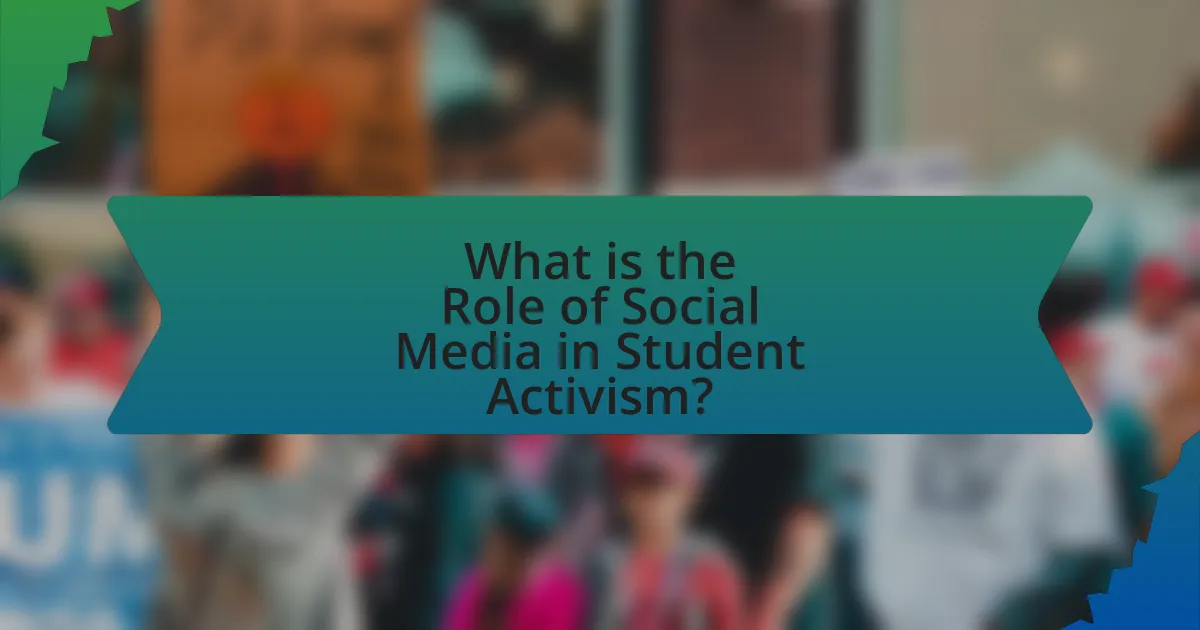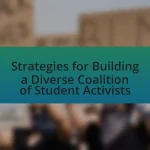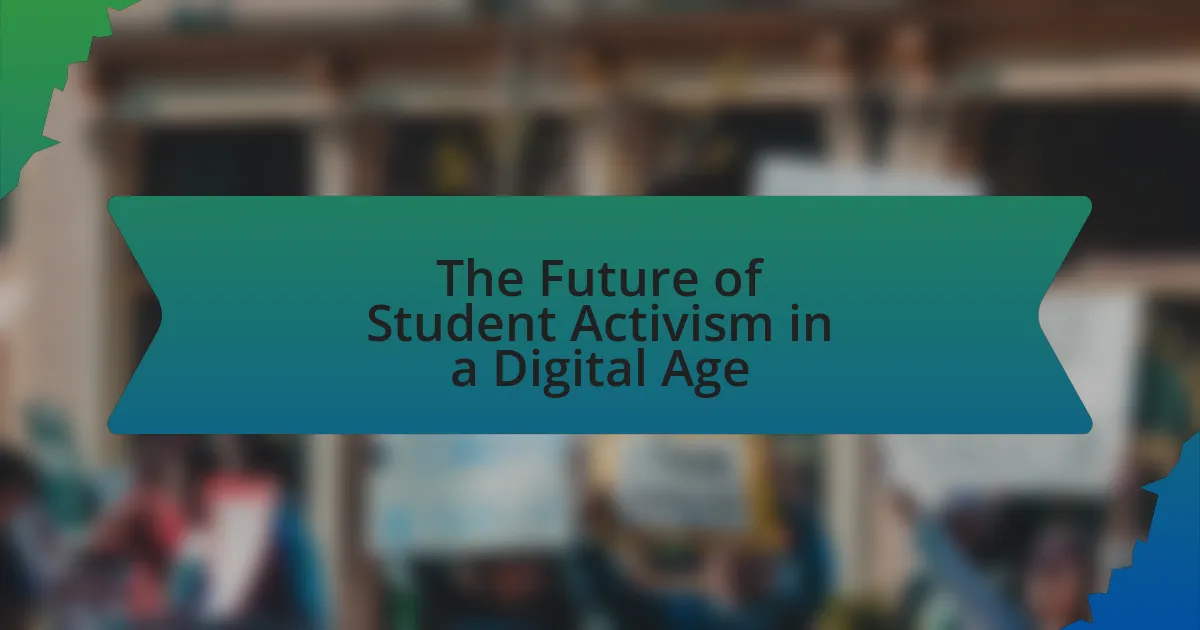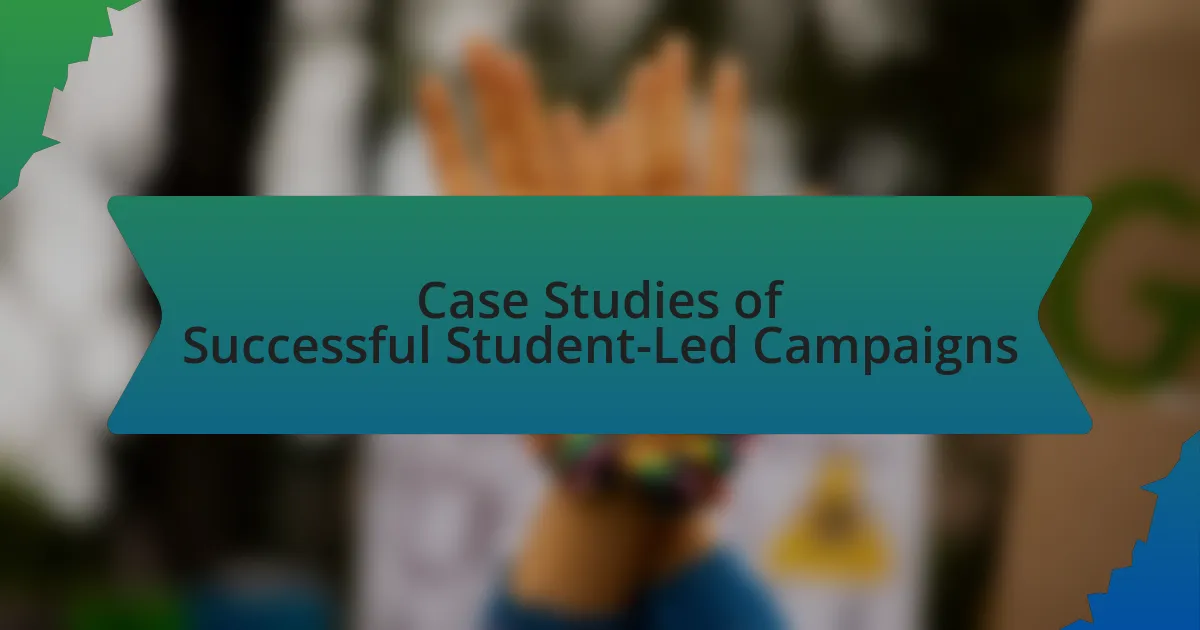The article examines the significant role of social media in student activism, highlighting its function as a platform for organizing, mobilizing, and amplifying voices on social issues. It discusses how social media has transformed activism by facilitating rapid communication and engagement, as evidenced by movements like Black Lives Matter and the Arab Spring. The article also addresses the historical context of social media’s rise, the influence of different platforms, the challenges activists face, and strategies for effective engagement. Additionally, it explores future trends and best practices for student activists in leveraging social media for impactful movements.

What is the Role of Social Media in Student Activism?
Social media plays a crucial role in student activism by providing a platform for organizing, mobilizing, and amplifying voices on social issues. It enables students to quickly disseminate information, coordinate events, and engage with a broader audience, thereby increasing the visibility of their causes. For instance, the use of hashtags like #BlackLivesMatter and #MeToo has facilitated global conversations and actions surrounding racial and gender equality, demonstrating how social media can unite students across different regions and backgrounds. Additionally, studies show that social media campaigns can lead to significant offline actions, such as protests and policy changes, highlighting its effectiveness as a tool for activism.
How has social media transformed student activism?
Social media has transformed student activism by providing a platform for rapid communication, organization, and mobilization of movements. This transformation is evident in events such as the Arab Spring, where platforms like Twitter and Facebook facilitated the coordination of protests and dissemination of information, leading to significant political changes in multiple countries. Additionally, studies show that social media increases engagement among students, with 70% of young activists reporting that social media played a crucial role in their involvement in movements, as highlighted in research by the Pew Research Center. This shift has enabled students to reach wider audiences, amplify their messages, and create a sense of community around shared causes, fundamentally altering the landscape of activism.
What historical context led to the rise of social media in activism?
The historical context that led to the rise of social media in activism includes the proliferation of the internet in the late 1990s and early 2000s, which facilitated rapid communication and information sharing. The emergence of platforms like Facebook, Twitter, and YouTube provided activists with tools to mobilize support, organize events, and disseminate information quickly and widely. Events such as the Arab Spring in 2010 demonstrated the power of social media in coordinating protests and raising global awareness, highlighting its effectiveness in grassroots movements. Additionally, the increasing accessibility of smartphones allowed individuals to document and share their experiences in real-time, further amplifying the impact of social media on activism.
How do different social media platforms influence student activism?
Different social media platforms influence student activism by providing unique tools for communication, organization, and mobilization. For instance, Twitter’s character limit encourages concise messaging, allowing students to quickly share updates and rally support for causes, as seen during the Black Lives Matter protests where hashtags like #BlackLivesMatter gained global traction. Facebook, with its group features, enables students to create communities, organize events, and share detailed information, which was pivotal during the 2011 Occupy Wall Street movement. Instagram’s visual focus allows for impactful storytelling through images and videos, effectively engaging younger audiences, as demonstrated by the widespread use of visual content in climate change activism. Each platform’s distinct characteristics shape how students engage with issues, mobilize peers, and amplify their voices in the public sphere.
Why is social media important for student activists?
Social media is important for student activists because it provides a platform for organizing, mobilizing, and amplifying their voices. This digital space allows student activists to reach a wider audience quickly, facilitating the dissemination of information and rallying support for their causes. For instance, during the 2011 Occupy Wall Street movement, social media played a crucial role in coordinating protests and sharing real-time updates, demonstrating its effectiveness in grassroots mobilization. Additionally, studies show that social media can increase engagement and participation among young people, making it a vital tool for student-led initiatives.
What advantages does social media provide for organizing protests?
Social media provides significant advantages for organizing protests by facilitating rapid communication, broadening outreach, and enabling real-time coordination. These platforms allow activists to quickly disseminate information about protest details, mobilizing participants efficiently. For instance, during the Arab Spring, social media was instrumental in organizing mass protests, with platforms like Twitter and Facebook being used to share updates and coordinate actions among thousands of participants. Additionally, social media’s ability to reach diverse audiences enhances visibility and support for causes, as seen in movements like Black Lives Matter, which gained international attention and solidarity through viral posts and hashtags. This interconnectedness fosters a sense of community and urgency, driving collective action more effectively than traditional methods.
How does social media facilitate communication among student activists?
Social media facilitates communication among student activists by providing instant access to information and enabling real-time interaction. Platforms like Twitter, Facebook, and Instagram allow student activists to share updates, organize events, and mobilize support quickly. For instance, during the 2018 March for Our Lives movement, students utilized social media to coordinate rallies and disseminate information, reaching millions in a short period. This rapid communication fosters community building and enhances the visibility of their causes, as evidenced by the significant engagement metrics seen in campaigns that leverage these platforms effectively.
What challenges do student activists face on social media?
Student activists face several challenges on social media, including misinformation, harassment, and algorithmic bias. Misinformation can undermine their campaigns, as false narratives spread rapidly, complicating efforts to mobilize support. Harassment, often gendered or targeted at specific identities, can deter participation and silence voices within activist movements. Additionally, algorithmic bias can limit the visibility of their posts, as social media platforms may prioritize content that aligns with mainstream narratives over grassroots activism. These challenges hinder the effectiveness of student activism online, as evidenced by studies showing that marginalized voices often face greater obstacles in digital spaces.
How do issues of misinformation impact student activism online?
Misinformation significantly undermines student activism online by distorting facts and creating confusion among activists and their audiences. This distortion can lead to misinformed decisions, reduced trust in legitimate movements, and fragmentation within activist groups. For instance, a study by the Pew Research Center found that 64% of Americans believe misinformation has caused confusion about basic facts, which can hinder the effectiveness of student-led campaigns. Additionally, misinformation can provoke backlash against student activists, as seen in various instances where false narratives have led to public outrage or mischaracterization of their goals. Thus, the prevalence of misinformation poses a critical challenge to the integrity and impact of student activism in the digital landscape.
What are the risks of surveillance and censorship for student activists?
Surveillance and censorship pose significant risks for student activists by undermining their ability to organize, communicate, and express dissent. These risks can lead to a chilling effect, where students may self-censor their speech and actions due to fear of repercussions, such as disciplinary actions or legal consequences. For instance, a report by the Electronic Frontier Foundation highlights that increased surveillance can result in the identification and targeting of activists, which can deter participation in movements. Additionally, censorship can limit access to information and hinder the dissemination of ideas, as seen in various countries where governments restrict social media platforms during protests. This combination of surveillance and censorship not only stifles free expression but also disrupts the collective power of student movements, ultimately affecting their effectiveness and reach.
How do student activists effectively use social media?
Student activists effectively use social media by leveraging platforms to organize events, raise awareness, and mobilize support for their causes. They create targeted campaigns that utilize hashtags to increase visibility and engage a wider audience, as seen in movements like #BlackLivesMatter, which gained traction through strategic social media use. Additionally, student activists share personal stories and experiences to humanize issues, fostering empathy and encouraging community involvement. Research indicates that social media can amplify messages, with studies showing that campaigns with strong online engagement can lead to increased participation in offline events, demonstrating the tangible impact of digital activism.
What strategies can enhance engagement on social media platforms?
To enhance engagement on social media platforms, utilizing interactive content such as polls, quizzes, and live videos is effective. Research indicates that posts featuring interactive elements can increase user interaction by up to 50%, as they encourage participation and feedback. Additionally, consistent posting schedules and the use of relevant hashtags can significantly improve visibility and engagement rates. A study by HubSpot found that brands that post consistently receive 67% more leads than those that do not. Engaging with followers through comments and direct messages also fosters a sense of community, leading to higher retention and interaction levels.
How can student activists measure the impact of their social media campaigns?
Student activists can measure the impact of their social media campaigns by analyzing engagement metrics such as likes, shares, comments, and follower growth. These metrics provide quantitative data that reflects audience interaction and reach. For instance, a study by the Pew Research Center found that 69% of adults in the U.S. use social media, indicating a significant platform for outreach. Additionally, tracking the use of specific hashtags related to the campaign can help assess visibility and participation levels. Surveys and feedback forms can also be employed to gather qualitative data on audience perceptions and the campaign’s effectiveness.
What are the future trends in social media and student activism?
Future trends in social media and student activism include increased use of decentralized platforms, enhanced multimedia storytelling, and a focus on mental health awareness. Decentralized platforms, such as Mastodon, allow students to organize without the constraints of traditional social media algorithms, promoting more authentic engagement. Enhanced multimedia storytelling through video and live streaming will enable students to share their messages more effectively, as evidenced by the rise of TikTok as a platform for activism. Additionally, the growing emphasis on mental health within activism reflects a shift towards holistic approaches, with campaigns increasingly addressing the emotional well-being of activists. These trends indicate a more dynamic and inclusive landscape for student activism in the future.
How might emerging technologies shape the landscape of student activism?
Emerging technologies significantly shape the landscape of student activism by enhancing communication, mobilization, and awareness. For instance, social media platforms like Twitter and Instagram allow students to quickly disseminate information, organize protests, and rally support on a global scale. According to a study by the Pew Research Center, 69% of U.S. adults use social media, which amplifies the reach of student-led movements and facilitates real-time engagement. Additionally, tools like live streaming and crowdfunding have empowered students to document their activism and secure financial support, further increasing their impact. These technologies create a more interconnected and responsive environment for student activism, enabling rapid responses to social issues and fostering solidarity across diverse groups.
What role will social media play in the next generation of student movements?
Social media will serve as a crucial tool for mobilizing and organizing the next generation of student movements. It enables rapid dissemination of information, allowing students to share their messages widely and engage with a global audience. For instance, the use of platforms like Twitter and Instagram has been pivotal in recent movements, such as the March for Our Lives and climate strikes, where hashtags and viral posts galvanized support and participation. Additionally, social media facilitates real-time communication and coordination among activists, enhancing their ability to respond quickly to events and challenges. This dynamic interaction not only amplifies their voices but also fosters a sense of community and solidarity among students across different regions.
What best practices should student activists follow on social media?
Student activists should prioritize authenticity, clarity, and engagement when using social media. Authenticity fosters trust and credibility, as followers are more likely to support genuine voices. Clarity in messaging ensures that the cause is easily understood, which is crucial for mobilizing support. Engagement with followers through comments, shares, and direct messages builds community and encourages participation.
Research indicates that campaigns with clear, authentic messaging and active engagement strategies are more successful in mobilizing support and raising awareness. For instance, a study by the Pew Research Center found that 69% of adults believe social media is an effective tool for activism, highlighting its potential when used correctly.




